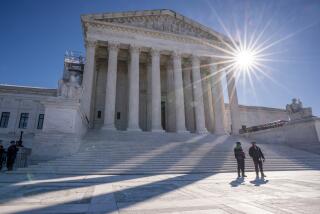Justices Must Work Faster to Cut Backlog, Jurist Says
- Share via
SAN FRANCISCO — A member of the special commission that studied the state Supreme Court’s growing caseload urged Friday that the justices adopt “pace-setting” time-standards to speed the decision-making process.
“It’s very obvious that the Supreme Court has to work at a faster pace to reduce its backlog,” said state Appellate Justice Harry W. Low of San Francisco.
Low, who served on a 10-member panel of experts that proposed an array of reforms in the court’s internal operations, also said that the justices should issue periodic public reports showing the status of its current docket of cases.
Delay and congestion have caused a “loss of confidence” in the entire judicial system, he said. “The public, I think, is very discouraged and disappointed with the lack of finality in the process.”
30-Page Report
Low spoke at a panel discussion on court delay sponsored by the Bar Assn. of San Francisco. His remarks came two months after the blue-ribbon commission, chaired by retired state Supreme Court Justice Frank K. Richardson, filed a 30-page report of suggested changes in court procedures.
The court faces a backlog of about 400 cases, about half of them complex and time-consuming capital appeals that come to the justices automatically after a verdict of death.
There are now no fixed time-limits in which the justices must decide the cases they select for formal review from among the nearly 5,000 petitions filed annually with the court. The justices, by authoritative estimate, spend about half of their time deciding which cases to grant such review.
The commission’s 17 recommendations, now under study by the justices, included proposals for expanding the court’s staff of research attorneys to help the justices in their review of death penalty cases and civil case appeals.
The group also proposed that the justices should adopt time limits for deciding “all but exceptional cases” and prepare periodic statistical reports to show the status of all pending cases.
Regular reports showing the number of opinions filed by each justice would help monitor the court’s progress, “disclosing trends and warning of potential problems,” the commission said.
The commission noted that the number of appeals to the court had increased from 19 a week to more than 100 a week in the last 28 years. The court had issued an average of 176 written opinions annually from 1966 to 1979. But from 1980 to 1986, the number dropped to an average of 129 a year.
Low, a former San Francisco Superior Court judge appointed to the appeal court in 1982 by then-Gov. Edmund G. Brown Jr., said Friday that adopting time-standards and progress-reports would help Supreme Court members better allocate their time. Until now, he said, “many of the justices had not known where their time was going.”
‘Pace-Setting System’
The court needs “some kind of pace-setting system” to clear its backlog, he said.
Low noted that he was speaking on April 15, the deadline for filing income tax returns, and that the same kind of time-limit “needs to be applied to every human institution,” including the high court.
It is uncertain when the justices will announce any action they take on the commission’s proposals.
A proposal to expand the court’s research staff, similar to recommendations made by the commission, is now being considered by the state Legislature.
More to Read
Get the L.A. Times Politics newsletter
Deeply reported insights into legislation, politics and policy from Sacramento, Washington and beyond. In your inbox twice per week.
You may occasionally receive promotional content from the Los Angeles Times.










